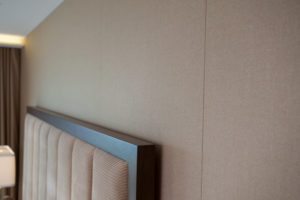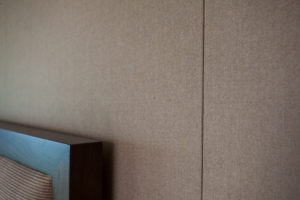Acoustic Wall Panel Installation in Vancouver
The Influence of Acoustic Wall Panels on Sound Quality and Noise Mitigation

Acoustic Wall Panels
The field of architectural acoustics concerns itself with those areas of science and engineering related to enhancing sound quality and speech intelligibility within an indoor space. The way sound behaves in a room can affect people, their moods and their productivity. The acoustic quality of a room should be a support for people and the activities that take place within it. The acoustic qualities of a room depend heavily on the room’s geometry, its construction and the density of its walls. Different rooms will generate different sound fields. A “hard room” is any room featuring minimal sound absorption. It is a room whose surfaces reflect most of the sound and noise originating within it. More common than the hard room, rooms with sound absorbent ceilings provide a greater degree of sound management and noise mitigation than hard rooms.
Inter-space Noise Control
Sound control and noise management are important factors that need to be addresses when designing rooms and spaces where many people will be seated or where sound quality is critical. These spaces include theaters, lecture halls and commercial marketplaces. Acoustic design takes in account sound control, reverberation control and sound absorption. Reverberation is defined as a serious of echoes generated by sound bouncing back and forth between two or more surfaces. The amount of time required before all of the echoes in a room fade is called the “reverberation time.” Sound and noise can be managed by means of acoustic treatments. When a wall surface is covered with acoustic upgrades, much of the sound is absorbed and echoes and reverberations do not get a chance to form.
Sound Management Solutions
A room is a tuned resonator and the sounds generated within that room take on the characteristics of the surfaces on which they reflect. This is why every interior space has its own acoustic signature. Opposing walls made of different materials and of different densities generate asymmetrical acoustical distortions that call for effective noise and sound management solutions. One does not need to apply noise canceling treatments to every square foot of a room to give it great acoustics. The very hardest rooms can be treated for noise and reverberation by hanging just few sound-dampening panels on its walls.
Acoustic Wall Panels

Acoustic Wall Panels
There are two basic types of sound-dampening acoustic panels — absorbers and diffusors. They are both important to the enhancement of acoustics within indoor spaces. The size and shape of a room and its window and door placement will determine the optimal place to hang these panels. As their name suggests, absorber panels “soak up” sound substantially reducing its reverberation time. Diffusors curtail sound reflections and break up pressure waves emanating from low frequency speaker drivers (“woofers”) through diffusion.
Acoustic wall panels that act as absorbers and diffusers often do not measure any larger than portraits and are commonly fixed to walls in the same manner as common wall decor items. Ceiling absorber panels are known in the industry as “clouds” and are installed on ceilings nearest a room’s primary refection point. The primary reflection point is the very first spot in a room that sound bounces off of after leaving a speaker’s lips or an amplifier on its way to the listener’s ear. The primary reflection point has the first and most damaging influence on sound.
Non-invasive acoustic wall panels greatly improve comfort within a work space by reducing stress. Designed for simple, fast and cost efficient installation, acoustic wall panels are easily installed and represent the ideal solution for those areas where acoustic enhancement is a desirable objective. They effectively control a sound field by accelerating the decay of echoes along a hard surface sound path.
They reduce incoherent noise that can interfere with specific and detailed communications within a speaking environment. Acoustic wall panels are a proven and effective sound management and noise mitigation tool. They accomplish all that they do by reducing reverberation and ambient noise levels in interior spaces by optimally reflecting and absorbing sound.
